
The International Union for Conservation of Nature (IUCN) Red List of Threatened Species, also known as the IUCN Red List or Red Data Book, founded in 1964, is an inventory of the global conservation status and extinction risk of biological species. A series of Regional Red Lists are produced by countries and organizations, which assess the risk of extinction to species within a political management unit.
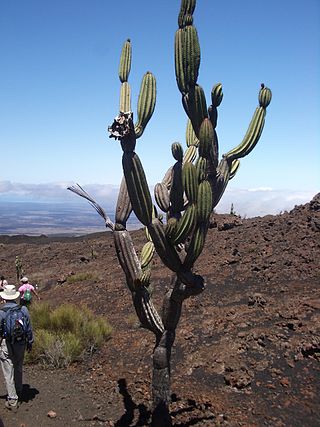
Jasminocereus is a genus of cacti with only one species, Jasminocereus thouarsii, endemic to the Galápagos Islands, territorially a part of Ecuador. In English it is often called the candelabra cactus. At maturity it has a branched, treelike habit, and may be up to 7 m (23 ft) tall. The stems are made up of individual sections with constrictions between them. Its creamy white to greenish flowers open at night and are followed by greenish to reddish fruits.

Jubaea is a genus of palms with one species, Jubaea chilensis or Jubaea spectabilis, commonly known in English as the Chilean wine palm or Chile cocopalm, and palma chilena in Spanish. It is native to southwestern South America and is endemic to a small area of central Chile between 32°S and 35°S in southern Coquimbo, Valparaíso, Santiago, O'Higgins, and northern Maule regions.

Prosopis glandulosa, commonly known as honey mesquite, is a species of small to medium-sized, thorny shrub or tree in the legume family (Fabaceae).

Astrophytum capricorne, the goat's horn cactus, is a species of flowering plant in the cactus family Cactaceae, that is native to the Coahuila regions of Northern Mexico. Growing to 25 centimetres (9.8 in) tall by 10 centimetres (3.9 in) wide in a ball or oval shape, it is grey-green in colour with 7 to 9 prominent ribs, very long twisted spines and yellow flowers with a red centre in summer.
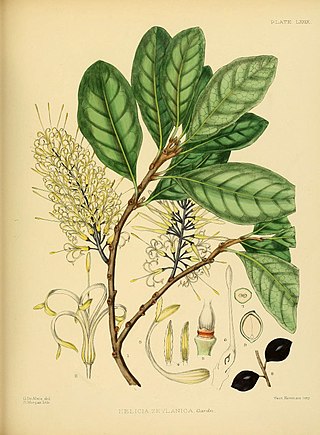
Helicia is a genus of 110 species of trees and shrubs, constituting part of the plant family Proteaceae. They grow naturally in rainforests throughout tropical South and Southeast Asia, including India, Sri Lanka, Indochina, Peninsular Malaysia to New Guinea and as far south as New South Wales.

Ferocactus cylindraceus is a species of barrel cactus which is known by several common names, including California barrel cactus, Desert barrel cactus, compass barrel cactus, and miner's compass. It was first described by George Engelmann in 1853.
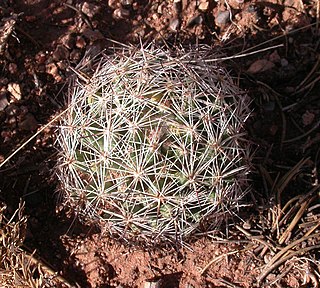
Escobaria vivipara is a species of cactus known by several common names, including spinystar, viviparous foxtail cactus, pincushion cactus and ball cactus. It is native to North America, where certain varieties can be found from Mexico to Canada. Most of these varieties are limited to the Mojave and Sonoran Deserts. The species epithet "vivipara" is due to the species' viviparous reproductive habit.
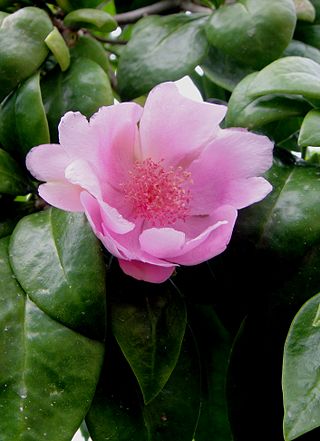
Leuenbergeria quisqueyana, commonly known as the Bayahibe rose, is a species of cactus that is endemic to the Caribbean island of Hispaniola, in the Dominican Republic.

Opuntia basilaris, the beavertail cactus or beavertail pricklypear, is a cactus species found in the southwest United States. It occurs mostly in the Mojave, Anza-Borrego, and Colorado Deserts, as well as in the Colorado Plateau and northwest Mexico. It is also found throughout the Grand Canyon and Colorado River region as well as into southern Utah and Nevada, and in the western Arizona regions along the Lower Colorado River Valley.

Opuntia humifusa, commonly known as the devil's-tongue, Eastern prickly pear or Indian fig, is a cactus of the genus Opuntia present in parts of the eastern United States, Mississippi and northeastern Mexico.

Parodia magnifica is a species of flowering plant in the family Cactaceae, native to southern Brazil. One of several species called ball cactus, it grows to 7–15 cm (3–6 in) tall by 45 cm (18 in) broad, with heavily ribbed, spherical to columnar, spiny and hairy stems, bearing pale yellow flowers in summer. Its natural habitat is cool, dry temperate grassland at elevations of up to 800 m (2,600 ft). Populations are sparse and fragmented, and it has been designated as “Endangered” by the IUCN Red List.

Echinocereus fendleri is a species of cactus known by the common names pinkflower hedgehog cactus and Fendler's hedgehog cactus. It is named in honor of Augustus Fendler.

Echinocereus viridiflorus is a species of cactus known by the common names nylon hedgehog cactus, green pitaya, and small-flowered hedgehog cactus. It is native to the central and south-central United States and northern Mexico, where it can be found in varied habitat types, including desert scrub, woodlands, dry grasslands, and short-grass prairie.

Consolea corallicola is a species of cactus known by the common names Florida semaphore cactus and semaphore pricklypear. It is endemic to Florida in the United States, where it is limited to the Florida Keys.

Echinocereus arizonicus is a species of cactus native to the Chihuahuan Desert region of Chihuahua, southwestern New Mexico and southeastern Arizona, as well as in the Superstition and Mescal Mountains of Central Arizona. An endangered variable of the species "Echinocereus triglochidiatus arizonicus" is found exclusively in sections of the Superstition, Mescal, and Pinal Mountains. Genetic studies have indicated that this variable of the species does not occur outside these mountain ranges.
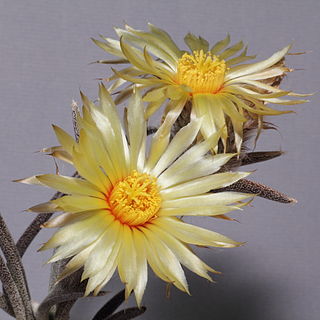
Astrophytum caput-medusae is a species of cactus native to Mexico, specifically the state of Nuevo León; the plant is reported to grow wild only at a single location. This species differs from the conventional star-shaped phenotype associated with other Astrophytum members. The plant is characterized by a cylindrical, reduced stem with triangular or cylindrical tubercles producing yellow flowers with orange perianth sections. Propagation by seed, tissue culture or via grafting have all been reported. The species is considered critically endangered by the IUCN due to the plant's limited growth range, destruction by livestock and over collection of wild specimen by plant collectors

Pygmaeocereus bylesianus is a critically endangered species of Pygmaeocereus from Peru.

Mammillaria surculosa is a species of flowering plant in the cactus family Cactaceae, native to north eastern Mexico, where it occurs in extremely isolated patches at altitudes of 950–1,200 m (3,120–3,940 ft). It is registered as “Endangered” by the IUCN Red List. Growing to 10 cm (3.9 in) tall by 50 cm (20 in) wide, this tiny plant forms colonies of spiny stems with relatively large, lemon yellow flowers in spring.

Cleistocactus smaragdiflorus is a species of Cleistocactus found in Bolivia and Argentina.





















